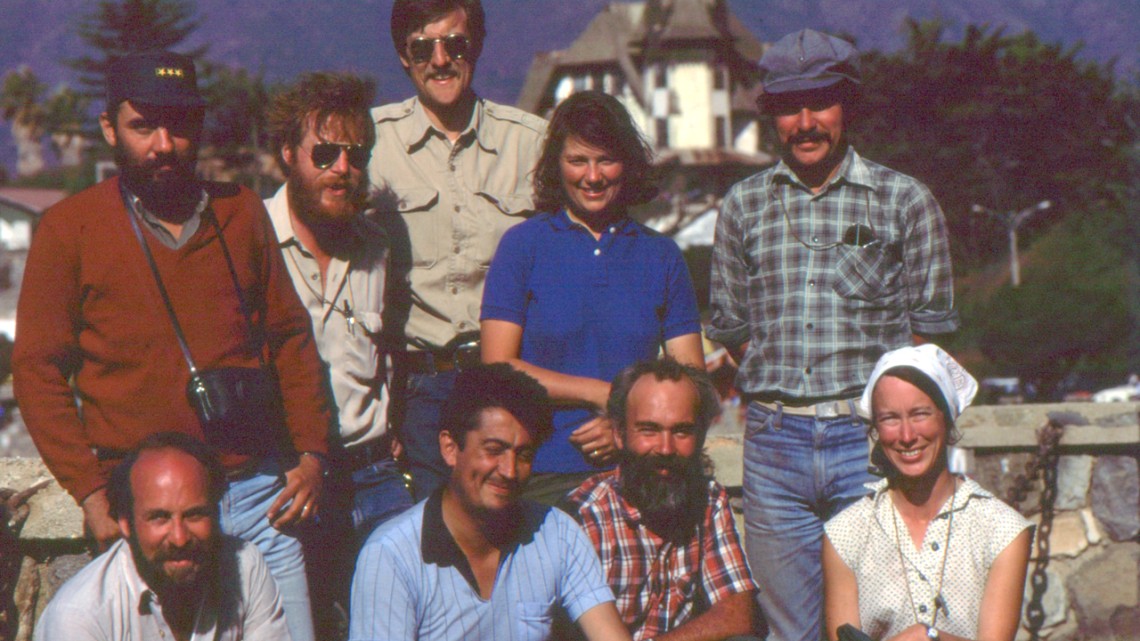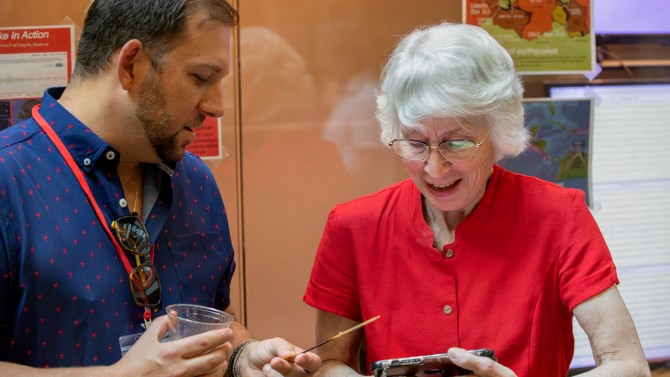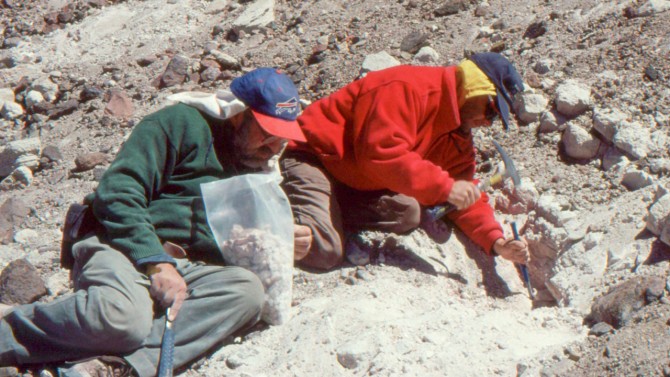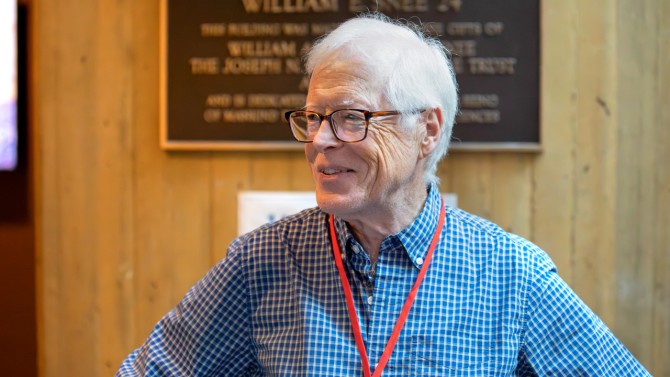
On a geology trip to the Andes, back row, from left: José Cortes, Rick Allmendinger, Manfred Strecker, Suzanne Mahlburg Kay and Miguel Palma; front row, Constantino Mpodozis, Estanislao Godoy, Victor Ramos and Teresa Jordan
Geologists celebrate 40 years of Andes research
By Laura Gallup, Cornell Chronicle
In 1980, when scientists were just beginning to understand what causes volcanoes and earthquakes, a cohort of Cornell geologists began meeting weekly to discuss the new frontier of plate tectonics.
The meetings continued for the next 40 years, spawning many trips to the Andes Mountains, hundreds of academic papers and more than 60 doctoral, masters and undergraduate theses. The Cornell group gained a robust understanding of how the Earth’s subterranean movements create mountain ranges, and of the relations between topography, structure, sedimentary basins and volcanism.
Seventy-five members and friends of the group – known as the Cornell Andes Project – came together on campus June 2-4 to celebrate their collective success.
“It was curiosity-driven; each of us saw marvelous opportunities in the Andes, and that it’d be a natural laboratory for the type of science that was on the cutting edge of each of our individual disciplines,” said Teresa Jordan, whose work focused on sedimentary basins as sources of mountain-building history and on surface processes in Chile’s Atacama Desert.
Jordan, the J. Preston Levis Professor of Engineering Emerita in the department of Earth and Atmospheric Sciences, in Cornell Engineering, was honored for her retirement at the June event, along with two other long-time members – her husband, Richard Allmendinger, professor emeritus of Earth and atmospheric sciences; and Suzanne Mahlburg Kay, the William & Katherine Snee Professor of Geological Sciences Emeritus.
The Andes is a desirable research spot for geologists because it is an active example of an oceanic plate moving under the continent, known as subduction, and creating high mountains – a simple system for study.
In 1981, Jordan and Allmendinger took their first trip to the Andes and linked up with geologists employed by the Argentine Geological Survey. They went back two years later, this time with Kay, and collaborated with researchers from Chile and Argentina. All three returned from the trip with concrete ideas that each turned into projects funded by the National Science Foundation.
“They asked me to go because they needed somebody who was knowledgeable about magmatism,” Kay said about her first trek to the Andes, a six-week trip. “It completely changed my life.”
Although initially none of the 1980s Cornell researchers spoke Spanish, they became fluent as they integrated into the local community and became life-long friends with many of their South American collaborators.
“Take yourself back 40 years ago at a time when there wasn’t internet and rapid communication,” said Kay, whose research revolves around the evolution of continental crust, with particular emphasis on the relation of regional tectonics to magmatic processes, the formation of the lower crust and the evolution of ore deposits.
“There wasn’t easy access to the existing local, high-quality, Spanish language studies. Our early studies were greatly enhanced by access to these publications and ideas, by what we continuously learned at South American geologic meetings, and by the collaborations that we developed.”
From 1996 to 2015, Kay – who has visited South America six to seven times a year since the 1980s – brought around 175 American students down for an intensive, hands-on geological summer field course in Argentina. She co-taught with instructors from the University of Buenos Aires, allowing students from both countries to take advantage of an international, collaborative learning experience.
Allmendinger said that two things distinguished the Cornell Andes Project from other projects in the region.
“One was the seamless integration across diverse earth science disciplines and the other was the anti-hierarchical nature of the project,” Allmendinger said. “Each faculty member was responsible for deciding what to study next and generating their own research grants to do so. This made us very nimble compared to other projects with more centralized leadership.”
The depth and success of the group was largely influenced by two senior faculty members in the Department of Earth and Atmospheric Sciences: Bryan Isacks, the William and Katherine Snee Professor of Geological Sciences Emeritus, and Arthur L. Bloom, professor emeritus, who passed away in 2017.
Over the last four decades, researchers involved in the Andes Project have become experts on the region’s geology.
“They had an international reputation, and as a graduate student you would read papers that came out of the project,” said Matthew Pritchard, professor of Earth and atmospheric sciences and director of the Institute for the Study of the Continents, who joined the Cornell faculty in 2003. “You were aware, if you were working in these areas, that this was one of the groups that was leading the world in these studies, in part because they were touching on it from a variety of disciplines.”
Modern Andean research has evolved – Cornell geoscientists now focus more on seismic and volcanic hazards, water and mineral resources. Yet students and faculty continue to build on the Cornell and South American researchers’ legacy and connections.
“The Andes Project was not only formative, or transformative, when I was young, but it was a very intellectually fertile and enriching community when I was older,” Jordan said of her time in the Andes Project. “A very reliable place where we respected the work of others. In fact, it's why we stayed at Cornell. We knew there were jobs elsewhere, but there’s not an Andes Project elsewhere.”
Media Contact
Get Cornell news delivered right to your inbox.
Subscribe



